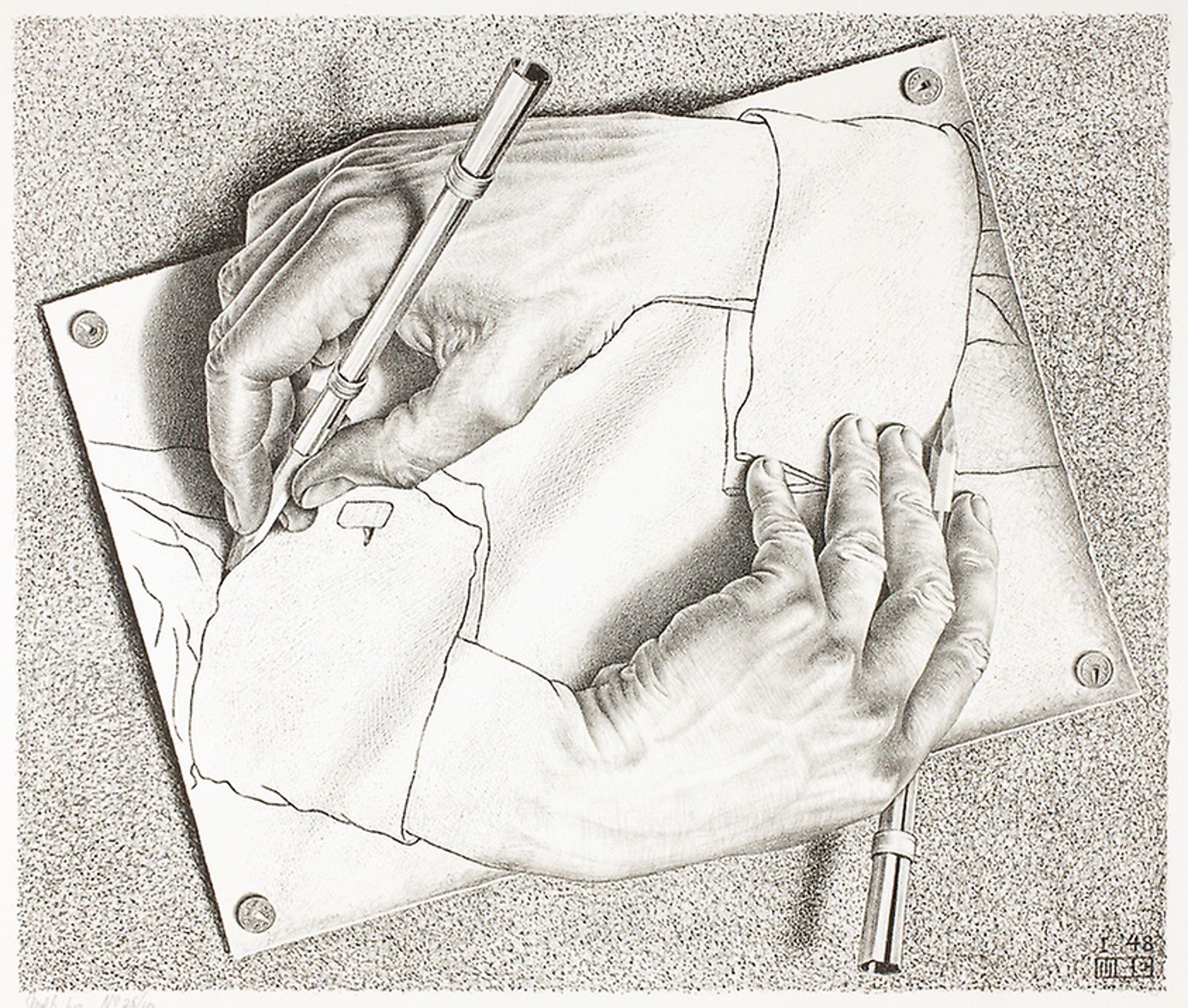Fine, Art: M.C. Escher
015 - m.C. escher
I don’t drink and I’ve never been able to casually hookup. I don’t have anything against either but these truths make weddings an anthropological nightmare, I mean, experience for me. I typically stay on the dance floor until the last song plays and then decide whether or not to join the after-party or go my own sober way. At this particular wedding, I opted to keep the party going.
It rolled over to the fancy hotel bar where puffs and moans could be heard in response to twenty dollar beers, so the groom invited everyone to the honeymoon suite where they had plenty to drink. Most were married or not free to mingle in this group. All but two: the groom’s friend, a fit engineer, and the last girl in the bride’s circle without a ring on her finger. This duo with different state IDs sat intertwined on the couch in the center of the room. Her legs rested across his lap. His tie still knotted perfectly, as if he just left his hotel room.
A woman a few years older than me with a two-glasses-of-wine smile approached me and said, “I heard you’re going to the Netherlands?!” Her husband’s job took them there for two years, so she gave me recommendations and I wrote them down. One was a museum of a graphic artist. She said it was trippy art and I had to check it out.
At 2 AM, the newlyweds, half asleep and over it, made no announcement and disappeared to their room. Everyone started to file out. I helped the parents clean up a little, so I was the last to arrive at the elevators. I could’ve snuck in with the two single people closing in on each other, but decided it was better to hang back and have the next one to myself. I heard the girl ask the guy if he was going to continue on with the others or if he wanted to see her room. He said, “I’ll come with you to see your room.” And she replied, “It’s nice. I can give you a little tour, but you can’t stay over.” The elevator doors closed. I didn’t hear his response.
I introduce to you: M.C. Escher
Maurits Cornelis Escher was an artist born in the Netherlands in 1898, the youngest of his engineer father’s five sons. He spent most of his life working outside the mainstream spotlight, but the hippy movement of the 1960s brought Escher attention. Considered to be a pioneer of psychedelic art, his creative process consisted of withdrawing himself from his real-life surroundings because they were so boring, and instead, embracing and illustrating his inner-visions.
When I entered the first room of Escher in Het Paleis, a royal residence beautifully converted into a museum, I felt immediately drawn to the images on the wall described as woodcut prints. I’d never seen anything like them before. I really had a hard time wrapping my head around this process of carving a reverse image out of a piece of wood and using ink and paper to produce a print. Escher was a master in this medium. Lucky for me and for a limited time, his teacher, Samuel Jesserun de Mesquita, had his artwork on display at the museum. The student and the teacher on exhibit together. I thought that was pretty cool.
As I wound through the exhibit, I started to see the trippy art I heard about at the after-party and my connection with the artist and how he sees the world grew stronger. I loved the subtle odes to darkness in his work, most evident in his drawing of a skull floating in the pupil of an eye or Hand with Reflecting Sphere. I wrote in a postcard to my friend, “A real thinker with a dark side. Like us.” It’s both an absolute pleasure and a confounding headache to look at his drawings of hands, infinite staircases, or water flowing upwards. This artist really had me looking, thinking and feeling.
In the next room, I came across his evolution and metamorphosis artwork which I read caught the attention of Mick Jagger and The Rolling Stones. They hoped Escher would create the cover art for their next album, Let It Bleed, but Escher declined the job and his correspondence with Mick put a huge smile on my face: “I cannot possibly accept any further assignments or spend any time on publicity.” Followed by and paraphrased: “And by the way, don’t call me Maurits.” signed M.C. Escher.
Perhaps humbled, Mick shouldn’t have taken offense. Escher also declined an inquiry from Stanley Kubrick who was looking for help in transforming his latest project into a fourth-dimensional film (2001: A Space Odyssey). MCE, maybe the coolest monogram I’ve seen, an artist with only so much time and a clear vision to create artworks depicting the varied realms and realities available to humans in our outer and inner-visions. Spending time and thought between these places doesn’t allow for extra-curricular courtship. I was inspired to learn that Escher was focused on the integrity of his work and charged on undisturbed by his suitors, regardless of name or fame. Timing is everything. Mick and Stanley weren’t so lucky. I think the opposite was true for the duo at the wedding. I only know one of their names. — Phillip Dillon
HERE ARE A FEW OTHER QUOTES OF escher’s THAT MADE ME THINK OR SMILE:
“It is in the nature of people to want to exchange ideas with each other. And I believe that, basically, every artist wants nothing more than to tell his fellow people what he has in mind. With all expressions of art, whether it is music, literature or visual arts, it is first and foremost a matter of: communicating to the outside world and make sensory perceptible a personal thought, a striking idea or an inner emotion.”
“We adore chaos because we love to produce order.”
“He who wonders discovers that this in itself is wonder.”
“I play a tiresome game.”
“If you want to express something impossible, you must keep to certain rules. The element of mystery to which you want to draw attention should be surrounded and veiled by a quite obvious, readily recognizable commonness.”
“To have peace with this peculiar life; to accept what we do not understand; to wait calmly for what awaits us, you have to be wiser than I am.”
“So let us then try to climb the mountain, not by stepping on what is below us, but to pull us up at what is above us, for my part at the stars; amen.”
And the written correspondence with Mick Jagger:
Dear Maurits,
For quite a time now I have had in my possession your book [M.C. Escher, The Graphic Work] and it never ceases to amaze me each time I study it! In fact I think your work is quite incredible and it would make me very happy for a lot more people to see and know and understand exactly what you are doing. In March or April this year, we have scheduled our next LP record for release, and I am most eager to reproduce one of your works on the cover-sleeve. Would you please consider either designing a “picture” for it, or have you any unpublished works which you might think suitable – the “optical illusion” idea very much appeals to me, although one like “Evolution” would of course be equally as suitable. And would say the same thing. You might even like to do a long one like “Metamorphosis” which we could then reproduce as a folding-out sleeve. It could be either in one colour or full colour, that would be up to you entirely.
Naturally, both you and your publishers would get full credits on the sleeve, and we could negotiate a fee on hearing of your decision to do it. I would be most grateful if you could contact Peter Swales or Miss Jo Bergman at the above address or telephone (reverse charge), and either will give you every necessary assistance. However, I am not so fortunate as to possess a Dutch interpreter, and so if you do not speak English or French, I would again be grateful if you could fix up somebody in Baarn to oblige.
Yours very sincerely,
MICK JAGGER
for ROLLING STONES LTD.
Escher’s Response:
Dear Sir,
Some days ago I received a letter from Mr. Jagger asking me to design a picture or to place at his disposal unpublished work to reproduce on the cover-sleeve for an LP record. My answer to both questions must be no, as I want to devote all my time and attention to the many commitments made; I cannot possibly accept any further assignments or spend any time on publicity.
By the way, please tell Mr. Jagger I am not Maurits to him, but very sincerely,
M.C. Escher
AND A VIDEO:
If you have an hour…
If you don’t have an hour…












